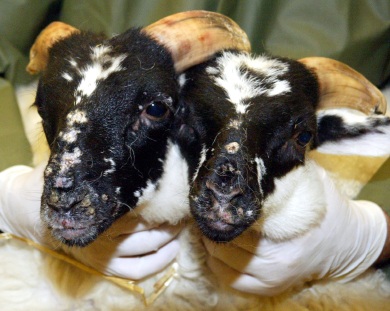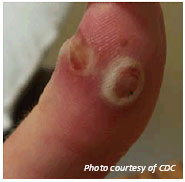Poxvirus Infections: Important threat to both animal and human health
Published on 25 November 2010 in Food, health and wellbeing

Introduction
Poxviruses are capable of causing disease in mammals, birds and insects. The most infamous member of this family is variola virus, the virus that causes smallpox, one of the most feared human diseases across the world for over 2000 years.
Although many poxviruses cause disease in a restricted number of animal species some of these viruses are also capable of causing disease in man. In other words, they are zoonotic. Most of these zoonotic poxvirus infections are self-limiting, occasionally painful, and generally cause little more than discomfort and inconvenience. On occasion however, disease can be serious enough to warrant hospitalisation and in extreme cases, particularly amongst the immuno-compromised, death can occur.
In the UK, the most important zoonotic poxviruses are those which infect livestock, namely orf virus (ORFV), pseudocowpoxvirus (PCPV) and bovine papular stomatitis virus (BPSV). In recent years, human infection has also been recorded with sealpox virus, vaccinia virus and cowpox virus (which despite its name is rarely found in cattle). In other countries, particularly Africa, monkeypox virus causes a more serious disease in humans. Its relevance being that it was inadvertently imported into the USA in 2003 through the international trade in exotic pet animals and resulted in over 70 people being affected, with 26% of these being hospitalised. Since then the US Government has banned the importation of all African rodents. To date there have been no reported cases of monkeypox in the UK.
Key Points
 Zoonotic poxvirus infections are caused when a poxvirus is transmitted from an animal host to humans. The animal host may or may not have obvious signs of disease and transmission may be as a result of mechanical transfer of the virus from infected fomites, including animal carcasses and products, through cutaneous abrasions, cuts or bites.
Zoonotic poxvirus infections are caused when a poxvirus is transmitted from an animal host to humans. The animal host may or may not have obvious signs of disease and transmission may be as a result of mechanical transfer of the virus from infected fomites, including animal carcasses and products, through cutaneous abrasions, cuts or bites.
- Infection most often results in lesions at the site of infection, but more widespread lesions can occur in the immuno-compromised. Lesions will normally resolve spontaneously in 4-6 weeks although occasional complications can occur.
- Disease is most commonly reported in those exposed through their occupation, but bystander exposure has been reported, including familial human to human transmission and in children at livestock petting zoos. The most common occupational exposures involve livestock farmers, shepherds, veterinarians and meat and wool processors.
- Many GPs have little or no experience of diagnosing poxvirus infections. Confounding diagnoses include; cutaneous anthrax, Staphylococcus aureus, Bartonella henselae, Francisella tularensis, Herpes simplex virus-1 and chickenpox. This often leads to misdiagnosis and implementation of inappropriate treatment regimens.
 There are currently no licensed drugs for treating zoonotic poxvirus infections in the UK, although antibiotics are sometimes prescribed to reduce the likelihood and affects of opportunistic secondary bacterial infections.
There are currently no licensed drugs for treating zoonotic poxvirus infections in the UK, although antibiotics are sometimes prescribed to reduce the likelihood and affects of opportunistic secondary bacterial infections.
- In a sheep farming community in Wales it was estimated that over one third of the community had been exposed to and suffered from orf with over 15% of these requiring time off work.
- Cowpoxvirus infections appear to be on the increase. Wild rodents are thought to be the reservoir of the virus in the UK, but most human infections arise through contact with domestic cats. One reason for the apparent increase may be that routine smallpox vaccination, that would have afforded cross-protection against cowpox, was discontinued in the early 1970s resulting in more of the population potentially being at risk of suffering disease following exposure to the virus.
- Potentially more dangerous zoonotic poxviruses are currently exotic to the UK, but the increase in the global trade of animals and animal products means that inadvertent importation of such viruses is possible. The lack of cross-protection afforded by the smallpox vaccine is also relevant for these viruses.
Research Undertaken
Research undertaken at the Moredun Research Institute has indicated that cidofovir is an effective antiviral drug that can be used to inhibit the replication of orf virus – probably the most common cause of zoonotic poxvirus infections in the UK. Although this work was done in sheep, the drug has subsequently been used by others to  demonstrate effectiveness in humans. Research, however, also demonstrated that treatment regimen is important to clinical outcome in that some regimens may exacerbate disease rather than cure it. Others have found topical imiquimod treatment to be effective.
demonstrate effectiveness in humans. Research, however, also demonstrated that treatment regimen is important to clinical outcome in that some regimens may exacerbate disease rather than cure it. Others have found topical imiquimod treatment to be effective.
Policy Implications
Human cases of disease caused by ORFV, PCPV and BPSV, which are endemic to the UK, have all been reported in recent years. Although normally self-limiting in healthy individuals severe disease can occur in immuno-compromised individuals. Disease is regarded by the Health Protection Agency to be under-reported meaning that the true cost of human infection is unknown.
Author
Dr Colin McInnes colin.mcinnes@moredun.ac.uk







